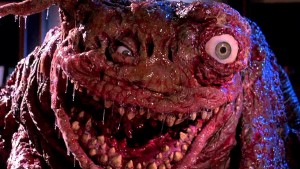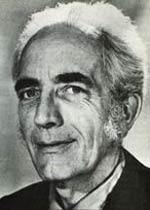The Monstrous: Ellen Datlow Presents the Nature of the Beast
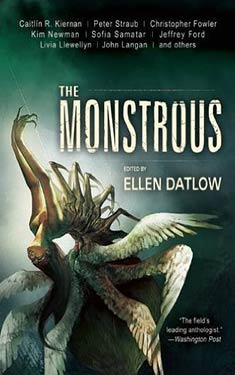 Had this book been titled Ellen Datlow’s Big Book of Monsters, there is little chance I would have picked it up. Not that I don’t love monsters. I am, in fact, a monster kid.
Had this book been titled Ellen Datlow’s Big Book of Monsters, there is little chance I would have picked it up. Not that I don’t love monsters. I am, in fact, a monster kid.
When I was five years old, previews for I Was a Teenage Frankenstein, The Blob, Attack of the Killer Shrews and their ilk flowed through the boxy, black-and-white television sets in dens and family rooms across the United States. Each of these creations looked potentially more marvelous that the one promoted the week before; and, once my parents made it clear that under no circumstances would I be allowed to attend these films, my fate was sealed. To this day, I will program the DVR to record almost any unfamiliar offering from the SyFy Channel or Chiller Network and watch it just long enough to see whatever ridiculous creature will be wreaking unconvincing CGI’d mayhem for the remainder of the two-hour time slot. Because really what I care about is that moment when the monster is revealed. I want to see the experiment gone wrong that’s kept chained in the cellar; the alien that emerges from the wrecked spacecraft; or, Godzilla’s latest sparring partner. After that first reveal, I have slowly learned over the decades to expect things to go downhill. But my enthusiasm for that first look has never waned.
My monster addiction is a visual thing. I have never cared much for monster stories. Verbal descriptions of the hideous tend to be anti-climactic and take too long. By the time I was twelve I quit expecting any of this stuff to be scary, but I want either an impressive crudeness or elegance to the creature, and I want to take it in at a glance. (And I will forestall some criticism here by saying that Clive Barker writes excellent monsters, China Mielville creates admirably alien aliens, and The Babadook recently scared the bejezzus out of me.)
By titling her new anthology The Monstrous, Ellen Datlow drew me in. She seemed to be promising “essence of the monster” rather than just the doings of the things themselves. And after editing what, something like 800 anthologies, I know that she knows her stuff. These are twenty-one stories that, while they will not duplicate the thrill of witnessing Ray Harryhausen’s Kraken lift its third arm out of the sea, can still satisfy the monster kid in all of us – and I know you are out there.
In her introduction, Datlow says she was looking for unusual monster stories, but she has not avoided such familiar creatures as vampires, serial killers, and ancient evils haunting tombs best left unopened. For the most part, her authors don’t depict creatures that depend on detailed description of their hideousness for effect. Adam-Troy Castro’s “The Totals,” features the widest array of nightmarish creatures, each tailor-made to terrify and inflict painful death on innocent victims. But his story is played for laughs. We meet them in an all-night diner where they gather to collect their weekly bonus pay. The comedy here stands out in three hundred pages of grimmer, sadder, bleaker stuff.
Datlow frontloads the anthology with literary firepower. Jeffrey Ford’s “A Natural History of Autumn” incorporates Japanese folklore into the high-stakes, globalized corporate world. Peter Straub offers a brilliant retelling of “Ashputtle,” the Grimm’s brothers version of the Cinderella story with the prince, the ball, and the happy ending replaced with a contemporary tale of life-long revenge carried out by an obese, homicidal kindergarten teacher. Caitlín Kiernan’s “The Beginning of the Year Without Summer” is a beautifully written, evocative tale, but – and I have had this experience before with Caitlín Kiernan – I am not quite sure what it’s about.
In any group of monster stories, curses will abound. In Gemma Files’ “A Wish from a Bone,” a group of archeologists who are also interested in careers on reality TV, open an ancient tomb to spectacularly dire results. One of the first of the crew to be possessed sprouts wings and spends the rest of the story flapping about overhead with her lungs dangling from her shattered chest cavity. Now that’s a cinematic image worthy of Eli Roth. The philosophical but ruthless vampire in Jack Dann’s and Gordner Dozios’ “Down Among the Dead Men” can be killed but his infection cannot. Stephen Graham Jones turns in a typically visceral tale set on a western-bound wagon train with a creature so foul that even his bleached bones pass on his monstrosity.
I have a couple of favorites: Sofia Samatar’s “How I Met the Ghoul” and John Langan’s “Corpsemouth.” In Samatar’s five-age vignette an understandably nervous reporter interviews an ancient, dangerous creature in an airport coffee shop. Both the reporter and the monster are in their way engaging characters.
Langan’s first person narrative takes a leisurely, novelistic approach and describes a family trip to visit the Scottish relatives of a young man’s recently deceased father. (Anyone who watches movies on the Chiller channel would know this is not a good idea.) The visit is a pleasant round of aunts, uncles, and cousins from several generations, all of whom offer dinners, single malt scotch, and sightseeing. One elderly great-uncle also tells the story of Corpsemouth, a creature from the days of King Arthur. It’s an ancient tale that will prove to have contemporary implications that tie the narrator to familial duties he has never imagined. This is a kind of curse, but on another level it is a monster kid’s dream come true.
(This review is based on an advanced ebook provided by Net Galley.)
“The End is Here!” Courtesy of Dover Books
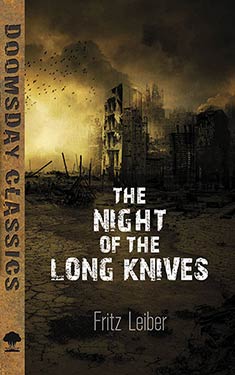 Dover Books has begun a new series of reprints called Doomsday Classics. Not the cheeriest series, perhaps, but they are pulling together a group of titles from the past 150 years that promises to combine academic interest with popular appeal for a broader science fiction readership. So far they have brought back into print Darkness and Dawn, a trilogy of novels from 1914 by George Allen England. England is largely forgotten today, but at the turn of the 20th century he was considered the American H.G. Wells. Also already on the shelves is Jack London’s The Scarlet Plague (1912). Coming up is Robertson Jeffries After London, a piece of Victorian science fiction new to me. Japan Sinks (1995) by Sakyo Komatsu is major work of Asian science fiction currently out-of-print in English.
Dover Books has begun a new series of reprints called Doomsday Classics. Not the cheeriest series, perhaps, but they are pulling together a group of titles from the past 150 years that promises to combine academic interest with popular appeal for a broader science fiction readership. So far they have brought back into print Darkness and Dawn, a trilogy of novels from 1914 by George Allen England. England is largely forgotten today, but at the turn of the 20th century he was considered the American H.G. Wells. Also already on the shelves is Jack London’s The Scarlet Plague (1912). Coming up is Robertson Jeffries After London, a piece of Victorian science fiction new to me. Japan Sinks (1995) by Sakyo Komatsu is major work of Asian science fiction currently out-of-print in English.
Their July 2015 release is The Night of the Long Knives, a disappointing effort by Fritz Leiber. Leiber wrote it as a short novel for the January 1960 issue of Amazing Science Fiction Stories, and it reads like a truncated version of what could have been a better, longer novel. Leiber sets up a convincing if by now familiar post-apocalyptic world, but the plot, such as it is, gets talked to death before it has a chance to take advantage of what Leiber is building on.
He opens with a scene familiar from classic Hollywood westerns, replacing the desert Southwest with an irradiated wasteland in the central United States. Two strangers warily approach one another, not sure if the next moments will bring bloodshed or comradeship. Actually, since this is a man and a woman, the option is bloodshed or sex, but even taking option number two will not discount resorting quickly to option number one. A propensity for murder has become second nature to those who wander the Deathlands. Leiber never satisfactorily explains why this is, but since he has created a first person narrator, such analysis would not be an option. Things just are the way they are.
The man and woman go for option number two, and the best part of the novel is their silent, methodical self-disarmaments, neither one willing to remove a weapon or an article of clothing until he or she is certain the other is making a similar concession. They also don’t speak, talking not being an accepted Deathland first-date behavior. And in this bleak, poisoned world beauty criteria have changed. The man –whose name, by the way, turns out to be Ray, the woman is Alice – is self-conscious about his eggshell baldness, but he is attracted to Alice’s radiation scars. One that traces a line from her eyebrow, across her forehead, and into her hairline provides “just the fillip” needed to make her beautiful. (Nice to think that after an atomic war the term “fillip” may make a comeback.)
This opening encounter takes up almost a third of the narrative, but things fall apart once it is over. Ray and Alice murder a handsome and to them offensively healthy man who shows up in a flying machine. They meet an old geezer they call Pop. He’s a scrounger, possibly too cracked to be dangerous. The trio flies off in the dead man’s aircraft that is preprogrammed to take them to the edges of the civilized zones where yet another war is in progress. There is little action and much boring talk. When the ship returns them to the Deathlands location they started from, they find the dying woman their civilized victim had come to save. There is more talk and the story winds down.
Leiber’s novel is a mess starting with the title. Evoking the series of assassinations that secured Hitler’s rise to power brings nothing to the narrative. The one other component that sparks any real interest is Pop’s proselytizing for his newfound commitment to stop wholesale murder. He has found a group of like-thinking ex-murderers who get together informally to help one another fight the urge when it comes on them. The loosely organized band is setting up meetings across the Deathlands. Right now it is just men, but they are thinking they should admit women. They joke about calling themselves Murderers Anonymous.
Leiber was an alcoholic who sought treatment several times. Among the Leiber papers held by the University of Indiana, there are several folders dated 1960 that contain Alcoholics Anonymous material. I don’t know how obvious or coded the AA references in The Night of the Long Knives would have been to readers of Amazing Science Fiction when the novel was published, nor what Leiber hoped to accomplish with their inclusion His recovery process must have been weighing heavily on his mind at the time, but Pop’s enthusiasm and Ray’s and Alices’s cautious curiosity about what he has to offer becomes just another loose end in the hodge-podge of the novel.
I place The Night of the Long Knives among the Leiber works for completists only.
(This review is based on an advance ebook provided by Net Galley.)
RYO Review: Solaris by Stanislaw Lem
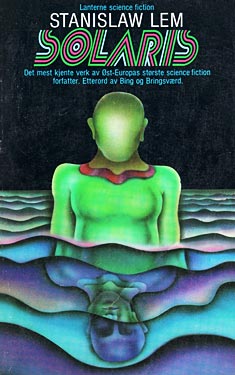
 Packed into his landing module and jettisoned from an interstellar spacecraft, Kris Kelvin heads towards Solaris. Solaris is a watery planet that has been under Earth’s observation for over a century. The consensus opinion holds that the ocean covering its surface is a single intelligent life form, but any detail of its nature or of the possibility of human communication with it has remained open to question. Over the past decade or so, interest in the planet has cooled among all but the most dedicated or obsessed Solarisists. The observation post on the planet was designed to house dozens of scientists. Kelvin will add a fourth to the three that are currently on board.
Packed into his landing module and jettisoned from an interstellar spacecraft, Kris Kelvin heads towards Solaris. Solaris is a watery planet that has been under Earth’s observation for over a century. The consensus opinion holds that the ocean covering its surface is a single intelligent life form, but any detail of its nature or of the possibility of human communication with it has remained open to question. Over the past decade or so, interest in the planet has cooled among all but the most dedicated or obsessed Solarisists. The observation post on the planet was designed to house dozens of scientists. Kelvin will add a fourth to the three that are currently on board.
Kelvin lands on a strangely desolate facility. Even the robots are inactive. His one friend among the scientists on board has committed suicide. The others he believes are possibly insane. And they are not alone. A caricature of an African tribal woman stalks the hallways and the living scientists appear to hide living beings in their quarters. I associate Stanislaw Lem with the brainy comedy of his short fiction, but the opening chapters of Solaris are as unnerving as any horror novel I have ever read.
RYO Review: We by Yevgeny Zamyatin
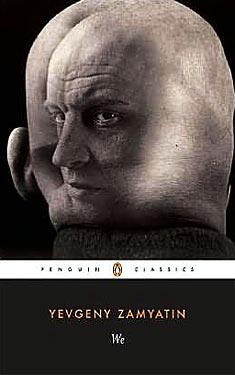
 D-503 is a model citizen of the One State society. As the designer of the Integral, the spaceship that will carry the wonders of One State to what they assume are the primitive people of other planets in the solar system, D-503 would be a distinguished citizen. But everyone in One State is equal, and D-503 does not question the wisdom of this system. He enjoys the regularity of his day, ordered by The Table of Hours: his wake-up time, his feeding hours, his work time, and his evenings in one of the huge auditoriums where citizens gather for instructive entertainment. He has a private hour, and sometimes a pink slip is issued that allows him a sexual interlude with the adoring and complacent O-90.
D-503 is a model citizen of the One State society. As the designer of the Integral, the spaceship that will carry the wonders of One State to what they assume are the primitive people of other planets in the solar system, D-503 would be a distinguished citizen. But everyone in One State is equal, and D-503 does not question the wisdom of this system. He enjoys the regularity of his day, ordered by The Table of Hours: his wake-up time, his feeding hours, his work time, and his evenings in one of the huge auditoriums where citizens gather for instructive entertainment. He has a private hour, and sometimes a pink slip is issued that allows him a sexual interlude with the adoring and complacent O-90.
Life is good for D-503. But one day, walk walking like thousands of others during the walking hour and with O-90 by his side, he sees for the first time I-330, and she will acknowledge his glance. D-503’s life, from this moment, will begin to spiral out of control.
RYO Review: The Red Tree by Caitlín R. Kiernan
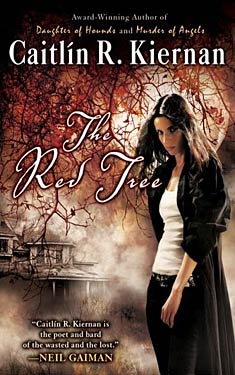
 Kiernan‘s novel brings the structure and machinery of a classic supernatural tale to bear on a contemporary story with a very contemporary protagonist.
Kiernan‘s novel brings the structure and machinery of a classic supernatural tale to bear on a contemporary story with a very contemporary protagonist.
Sarah Crow, a midlist novelist, has suffered from writer’s block since the traumatic end of her years-long relationship with Amanda. She has retreated from Atlanta to a remote farmhouse in Rhode Island. (If only Crow watched movies on either Chiller Network or Showtime Beyond, she would have known this was a bad idea.) The house has minimal amenities, but sits on lovely acreage and has an out-of-state landlord not likely to disturb her writing. Sarah has died at this house.
WoGF Review: The Vampire Tapestry by Suzy McKee Charnas
 Guest blogger and WWEnd Uber User, Charles Dee Mitchell, has contributed a great many book reviews to WWEnd including his blog series Philip K. Dickathon and The Horror! The Horror! He can also be found on his own blog www.potatoweather.blogspot.com.
Guest blogger and WWEnd Uber User, Charles Dee Mitchell, has contributed a great many book reviews to WWEnd including his blog series Philip K. Dickathon and The Horror! The Horror! He can also be found on his own blog www.potatoweather.blogspot.com.
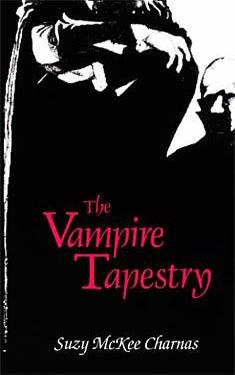 Suzy McKee Charnas published her vampire novel in 1980. That was four years after Anne Rice had beguiled the American pubic with her romantic and sexed-up vampires. Charnas’ effort must have seemed pretty dry stuff by comparison, but it garnered good reviews and has stayed stubbornly in print. And it is a remarkable piece of work: a vampire tale stripped of gothic trappings, sexual metaphors (although not of sex), and most all the traditional attributes writers attribute to undying bloodsuckers.
Suzy McKee Charnas published her vampire novel in 1980. That was four years after Anne Rice had beguiled the American pubic with her romantic and sexed-up vampires. Charnas’ effort must have seemed pretty dry stuff by comparison, but it garnered good reviews and has stayed stubbornly in print. And it is a remarkable piece of work: a vampire tale stripped of gothic trappings, sexual metaphors (although not of sex), and most all the traditional attributes writers attribute to undying bloodsuckers.
Dr. Edgar Wyland is not human. He lives by drinking the blood of his prey, and tracking that prey and overcoming that prey is his chief concern. Although he kills when he finds it necessary, he prefers to use the needle like projection under his tongue to take only what he needs to stay alive. His bite, even when fatal, does not produce new vampires. To his knowledge, he is the only one of his kind on earth. He has lived for centuries, and one of his greatest challenges is to learn, after a period of hibernation that may last for months or years, how to fit into the new society he encounters. The rapid advance of technology in the 20th century has made that transition trickier, but he does well for himself, taking on manual labor when nothing better presents itself.
Hell is Adaptations: Carrie
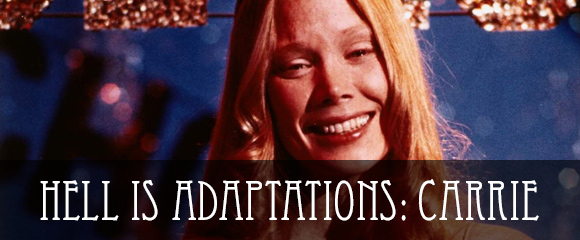
Horror fans owe Tabitha King a dozen roses, a box of chocolates, something. When her husband Stephen tossed the unfinished manuscript of his first novel into the trash, it was Mrs. King who fished it out, read it over, and convinced him to finish it. And so we have Carrie and possibly all that has come after it.
I am not a Stephen King reader, and so, almost forty years after its publication, Carrie is the first of his novels I have read. However, on whatever Friday in 1976 Brian de Palma’s film version opened in Dallas, I was in line. I had seen de Palma’s films Sisters, Phantom of the Paradise, and Obsession and loved them all – well, maybe I admired Obsession more than it loved it. Those films and a poster featuring Sissy Spacek covered in blood got myself and some friends to the theater for that Friday bargain matinee. We expected to enjoy ourselves. We had no idea just how much fun the next ninety-eight minutes were going to be.
WoGF Review: The Falling Woman by Pat Murphy
 Guest blogger and WWEnd Uber User, Charles Dee Mitchell, has contributed a great many book reviews to WWEnd including his blog series Philip K. Dickathon and The Horror! The Horror! He can also be found on his own blog www.potatoweather.blogspot.com.
Guest blogger and WWEnd Uber User, Charles Dee Mitchell, has contributed a great many book reviews to WWEnd including his blog series Philip K. Dickathon and The Horror! The Horror! He can also be found on his own blog www.potatoweather.blogspot.com.
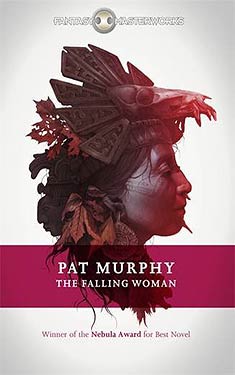 When one of the local workers on a Yucatan archeological site breaks his ankle, the local hospital fixes him up but his mother, the cook for the archeological team, insists that the local curandera be brought in to check him out as well. This old woman also wants to meet Elizabeth Butler, the middle-aged and well-known leader of the team. She identifies Butler as a witch.
When one of the local workers on a Yucatan archeological site breaks his ankle, the local hospital fixes him up but his mother, the cook for the archeological team, insists that the local curandera be brought in to check him out as well. This old woman also wants to meet Elizabeth Butler, the middle-aged and well-known leader of the team. She identifies Butler as a witch.
Butler is not bothered by this opinion. She can even appreciate it. All her life she has lived with shadows of the past inhabiting her world. This has made her an excellent archeologist, although on this dig for the first time one of these “shadows” has begun to speak to her. But Butler knows that a witch has power, which is better than being crazy, a diagnosis that removes your power and puts you under the power of others. She has been considered crazy in her life as well. Years before, when she saw no way out of a marriage that was suffocating her, she slit her wrists. This suicide attempt got her institutionalized. When she got out, she abandoned her husband and small daughter, went back to school, and began the life she has now.
WoGF Review: Mr. Fox by Helen Oyeyemi
 Guest blogger and WWEnd Uber User, Charles Dee Mitchell, has contributed a great many book reviews to WWEnd including his blog series Philip K. Dickathon and The Horror! The Horror! He can also be found on his own blog www.potatoweather.blogspot.com.
Guest blogger and WWEnd Uber User, Charles Dee Mitchell, has contributed a great many book reviews to WWEnd including his blog series Philip K. Dickathon and The Horror! The Horror! He can also be found on his own blog www.potatoweather.blogspot.com.
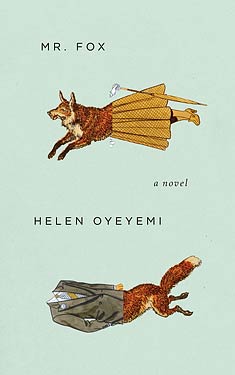 When I finished Helen Oyeyemi‘s novel, Mr. Fox, I immediately turned back to the opening chapter. It wasn’t that I had so enjoyed it that I planned to read the whole thing over. I was just trying, although it had been only a matter of a couple of days, to remember how on earth this thing had begun.
When I finished Helen Oyeyemi‘s novel, Mr. Fox, I immediately turned back to the opening chapter. It wasn’t that I had so enjoyed it that I planned to read the whole thing over. I was just trying, although it had been only a matter of a couple of days, to remember how on earth this thing had begun.
In the first chapter, Mr. St. John Fox, who despite his high-flown name appears to be the successful author of violent potboilers, receives a visit from Mary Foxe. When he hears her come in, he assumes at first it must be his wife Daphne, a woman we will learn later spends much of her time in her room, depressed and suicidal. Mr. Fox has not seen Mary for six or seven years. He tells her he loves her. They have a brief, odd conversation which ends when Mary says, “You don’t love me. You love that.” She bares her breasts, lifts her dress up over her crotch, pulls her hair, and slaps herself on the face.
How could I have forgotten such an opening? In my defense I can only say that a lot happens in Oyeyemi’s brief novel. In the next pages, Mary appears as an importunate fan and fledgling writer vying for Mr. Fox’s attention in an exchange of letters dated 1936. There is another narrative thread involving Mr. Fox and Daphne. There are interpolated stories, apparently the work of Mr. Fox, although a couple may be Mary’s and some may appear just for effect. And Mary, by the way, is not a real human being. She is Mr. Fox’s muse, a constant cause of Daphne’s jealousy, at least until they get to know one another toward the end of the novel.
WoGF Review: The Faded Sun: Kesrith by C. J. Cherryh
 Guest blogger and WWEnd Uber User, Charles Dee Mitchell, has contributed a great many book reviews to WWEnd including his blog series Philip K. Dickathon and The Horror! The Horror! He can also be found on his own blog www.potatoweather.blogspot.com.
Guest blogger and WWEnd Uber User, Charles Dee Mitchell, has contributed a great many book reviews to WWEnd including his blog series Philip K. Dickathon and The Horror! The Horror! He can also be found on his own blog www.potatoweather.blogspot.com.
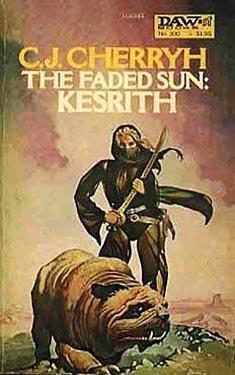 Anytime I have considered entering C. J. Cherryh‘s Alliance-Union Universe, I think about Anthony Trollope. With either author I have always thought that if I read one of their books and liked it, I could spend the rest of my life reading the rest of them. That might be more true of Trollope than Cherryh, since although she has him beat 60 novels to 48, his are much more fantastically long. Then again she continues to write, so it could go either way. There is another odd similarity between the two, Cherryh uses series of novels to explore every possible aspect of her far future history, somewhat as Trollope presented a panoramic view of Victorian English society. But I am stretching things.
Anytime I have considered entering C. J. Cherryh‘s Alliance-Union Universe, I think about Anthony Trollope. With either author I have always thought that if I read one of their books and liked it, I could spend the rest of my life reading the rest of them. That might be more true of Trollope than Cherryh, since although she has him beat 60 novels to 48, his are much more fantastically long. Then again she continues to write, so it could go either way. There is another odd similarity between the two, Cherryh uses series of novels to explore every possible aspect of her far future history, somewhat as Trollope presented a panoramic view of Victorian English society. But I am stretching things.
I decided to start Cherryh with this relatively early novel. I founds its 250 pages tough going. But I won’t pretend to extrapolate from this single read what spending time with Cherryh’s forty-year-long career might be like.
I see where other readers love her detailed description of the mri and the regul, the alien species inhabiting Kesrith. (For some reason these names are not capitalized, which seems like writing about the french or the somalians.) I quickly learned enough about each species to find them thoroughly unsympathetic. Which is fine, I don’t need to like the characters in a novel to enjoy the novel. But once two human characters appear is was a relief akin to running into an old friend in a foreign country. Finally here were motivations and actions I could understand and not want to strangle the characters for having.



















 Full Details
Full Details

